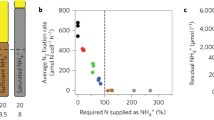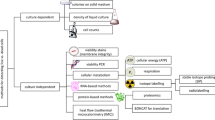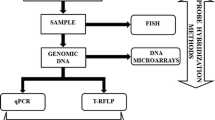Abstract
Microorganisms in natural environments have evolved to withstand fluctuations in physical and chemical conditions. This means that they often manifest very different biochemical and morphological features compared with those seen during laboratory culture. A major limitation in natural ecosystems is nutrient limitation under which microorganisms are exposed to starvation conditions and grow slowly or not at all. This review identifies the role of inimical processes on microbial properties such as the responses to starvation that may result in the adoption of viable but nonculturable (VBNC) states, discusses the problems that altered physiological states pose for detection and identification and highlights novel methods that have been developed to circumvent these difficulties. These factors dictate that to survive and respond to environmental stimuli, a cell must have evolved sophisticated programs of gene expression. These include the sigma factor rpoS that directs RNA polymerase to transcribe genes whose expression aids survival during severe nutrient limitation or cell-cell communication systems that promote a concerted population response termed quorum sensing.
Similar content being viewed by others
References
Gottschal, J. C. (1990) Phenotypic responses to environmental changes. FEMS Microbiol. Ecol. 74, 93–102.
Edwards, C. (1999) Some problems posed by natural environments for monitoring microorganisms. In Environmental monitoring of bacteria (Edwards, C., ed.) Humana, Totowa, NJ, pp. 1–13.
McDougald, D., Rice, S. A., Weichart, D., and Kjelleberg, S. (1998) Nonculturability: adaptation or debilitation? FEMS Microbiol. Ecol. 25, 1–9.
Edwards, C. (1996) Assessment of viability of bacteria by flow cytometry. In Flow cytometry: Applications in Cell Culture (Al-Rubeai, M. and Emery, A. N., eds.), Marcel Dekker, New York, pp. 291–310.
Head, I. M. (1999) Recovery and analysis of ribosomal RNA sequences from the environment. In Environmental monitoring of bacteria (Edwards, C., ed.) Humana, Totowa, NJ, pp. 139–174.
Pickup, R. (1991) Development of methods for the detection of specific bacteria in the environment. J. Gen. Microbiol. 137, 1009–1019.
Cappelier, J. M., Minet, J., Magras, C., Colwell, R. R., and Federighi, M. (1999) Recovery in embryonated eggs of viable but nonculturable Campylobacter jejuni cells and maintenance of ability to adhere to Hela cells after resuscitation. Appl. Environ. Microbiol. 65, 5154–5157.
Alexander, E., Pham, D., and Steck, T. R. (1999) The viable but nonculturable condition is induced by copper in Agrobacterium tumefaciens and Rhizobium leguminosarum. Appl. Environ. Microbiol. 65, 3754–3756.
Caro, A., Got, P., Lesne, J., Binard, S., and Baleux, B. (1999) Viability and virulence of experimentally stressed nonculturable Salmonella typhimurium. Appl. Environ. Microbiol. 65, 3229–3232.
Warner, J. M. and Oliver, J. D. (1998) Randomly amplified polymorphic DNA analysis of starved and viable but nonculturable Vibrio vulnificus cells. Appl. Environ. Microbiol. 64, 3025–3038.
Yamamoto, H., Hashimoto, Y., and Ezaki, T. (1996) Study of nonculturable Legionella pneumophila cells during multiple nutrient starvation. FEMS Microbiol. Ecol. 20, 149–154.
Collwell, R. R., Brayton, P., Herrington, D., Tall, B., Huq, A., and Levine, M. M. (1996) Viable but nonculturable Vibrio cholerae 01 revert to a cultivable state in the human intestine. World J. Microbiol. Biotechnol. 12, 28–31.
Lleo, M. D., Tafi, M. C., and Canepari, P. (1998) Nonculturable Enterococcus faecalis cells are metabolically active and capable of resuming active growth. Syst. Appl. Microbiol. 21, 333–339.
Lazaro, B., Carcamo, J., Audicana, A., Perales, I., and FernandezAstorga, A. (1999) Viability and DNA maintenance in nonculturable spiral Campylobacter jejuni cells after long term exposure to low temperatures. Appl. Environ. Microbiol. 65, 4677–4681.
Tholozan, J. L., Cappelier, J. M., Tissier, J. P., Delattre, G., and Federighi, M. (1999) Physiological characterization of viable but nonculturable Campylobacter jejuni cells. Appl. Environ. Microbiol. 65, 1110–1116.
Weichart, D., McDougald, D., Jacobs, D., and Kjelleberg, S. (1997) In situ analysis of nucleic acids in cold-induced nonculturable Vibrio vulnificus. Appl. Environ. Microbiol. 63, 2754–2758.
Rigsbee, W., Simpson, L. M., and Oliver, J. D. (1997) Detection of viable but nonculturable state in Escherichia coli O157:H7. J. Food Safety 16, 255–262.
Porter, J., Deere, D., Pickup, R., and Edwards, C. (1996) Fluorescent probes and flow cytometry: new insights into environmental bacteriology. Cytometry 23, 91–96.
Porter, J., Deere, D., Pickup, R., and Edwards, C. (1997) Going with the flow — flow cytometry in environmental microbiology. FEMS Microbiol. Ecol. 24, 93–101.
Lloyd, D., Thomas, K. L., Hayes, A., Hill, B., Hales, B. A., Edwards, C., et al. (1998) Micro-ecology of peat: minimally-invasive analysis using confocal microscopy, membrane inlet mass spectrometry and PCR amplification of metanogen-specific gene sequences. FEMS Microbiol. Ecol. 25, 179–188.
Porter, J., Pickup, R. W., and Edwards, C. (1997) Evaluation of flow cytometric methods for the detection and viability assessment of bacteria from soil. Soil Biol. and Biochem. 29, 91–100.
Deere, D., Porter, J., Pickup, R., and Edwards, C. (1996) Dircet analysis of starved. Acromonas salmonioida. J Fish Diseases 19, 459–467.
Porter, J., Pickup, R., and Edwards, C. (1995) Membrane hyperpolarisation by valinomycin and its limitations for bacterial viability assessment using rhodamine 123 and flow cytometry. FEMS Microbiol. Lett, 132, 259–262.
Porter, J., Edwards, C., and Pickup, R. (1995) Rapid assessment of physiological status in Escherichia coli using fluorescent probes. J. Appl. Bacteriol. 79, 399–408.
Barer, M. R., Kaprelyants, A. S., Weichert, D. H., Harwood, C. R., and Kell, D. B. (1998) Microbial stress and culturability: conceptual and operational domains. Microbiol. 144, 2009–2010.
Bloomfield, S. F., Stewart, G. S. A., Dodd, C. E. R., Booth, I. R., and Power, E. G. M. (1998) The viable but nonculturable phenomenon explained? Microbiol. 144, 1–3.
Nystrom, T., Flardh, K., and Kjelleberg, S. (1990) Responses to multiple nutrient starvation in the marine Vibrio sp. strain CCUG 15956. J. Bacteriol. 172, 7085–7097.
Nystrom, T., Olsson, R. M., and Kjelleberg, S. (1992) Survival, stress resistance and alterations in protein expression in the marine Vibrio dp. S14 during starvation for different individual nutrients. Appl. Environ. Microbiol. 58, 55–65.
Nystrom, T. (1998) To be or not to be: the ultimate decision of the growth-arrested cell. FEMS Microbiol. Rev. 21, 283–290.
VanBogelen, R. A., Greis, K. D., Blumenthal, R. M., Tani, T. T., and Matthews, R. G. (1999) Mapping regulatory networks in microbial cells. Trends Microbiol. 7, 320–328.
Weichart, D. and Kjelleberg, S. (1996) Stress resistance and recovery potential of culturable and viable but nonculturable cells of Vibrio vulnificus. Microbiol. 142, 845–853.
Oliver, J. D. and Bockian, R. (1995) In vivo resuscitation and virulence towards mice of viable but nonculturable cells of Vibrio vulnificus. Appl. Environ. Microbiol. 61, 2620–2623.
Loewen, P. C. and Hengge-Aronis, R. (1994) The role of the sigma factor σS (KatF) in bacterial global cell regulation. Ann. Rev. Microbiol. 48, 53–80.
Foster, J. W. and Spector, M. P. (1995) How Salmonella survive against the odds. Ann. Rev. Microbiol. 49, 145–174.
Schellhorn, H. E., Audia, J. P., Wei, L. I. C., and Chang, L. (1998) Identification of conserved RpoS-dependent stationary phase genes of Escherichia coli. J. Bacteriol. 180, 6283–6291.
Huisman, G. W. and Kolter, R. (1994) Sensing starvation: A homoserine lactone-dependent signaling pathway in Escherichia coli. Science 265, 537–539.
Rinas, U., Hellmuth, K., Kang, R., Seegar, A., and Schlieker, H. (1995) Entry of Escherichia coli into stationary phase is indicated by endogenous and exogenous accumulation of nucloobasos, App. Environ. Microbiol 61, 4147–4151.
Huisman, G. W., Siegele, D. A., Zambrano, M. M., and Kolter, R. (1996) Morphological and physiological changes during stationary phase. In Escherichia coli and Salmonella typhimurium: Cellular and Molecular Biology. (Neidhardt, F. C., et al. eds.) American Society for Microbiology, Washington, DC, pp. 1672–1682.
Kolter, R., Siegele, D. A., and Tormo, A. (1993) The stationary phase of the bacterial life cycle. Ann. Rev. Microbiol. 47, 855–874.
Zambrano, M. M., Siegele, D. A., Almiron, M., Tormo, A., and Kolter, R. (1993) Microbial competition: Escherichia coli mutants that take over stationary phase cultures. Science 259, 1757–1760.
Shapiro, J. A. (1997) Genome organisation, natural genetic engineering and adaptive mutation. Trends Genet. 13, 98–104.
Foster P. L. (1993) Adaptive mutation: The uses of adversity. Ann. Rev. Microbiol. 47, 467–504.
Chang, L., Wei, L. L. C., Audia, J. P., Morton, R. A., and Schellhorn, H. H. (1999) Expression of the Escherichia coli NRZ nitrate reductase is highly growth phase dependent and is controlled by RpoS, the alternative vegetative sigma factor. Mol. Microbiol. 34, 756–766.
Spector, M. P., del Portillo, F. G., Bearson, S. M. D., Mahmud, A., Finlay, B. B., Dougan, G., et al. (1999) The rpoS-dependent starvation stress response locus stiA encodes a nitrate reductase (narZYWV) required for carbon starvation inducible thermotolerance and acid tolerance in Salmonella typhimurium. Microbiol. 145, 3035–3045.
Adams, J. L. and McLean, R. J. C. (1999) Impact of rpoS deletion on Escherichia coli biofilms. Appl. Environ. Microbiol. 65, 4285–4287.
Hales, L. M. and Shuman, H. A. (1999) The Legionella penumophila rpoS gene is required for growth within Acanthamoeba castellanii. J. Bacteriol. 181, 4879–4889.
Cognault, C. and Norel, F. (1999) Comparison of the abilities of Salmonella typhimurium rpoS, aroA and rpoS aroA strains to elicit humoral immune reponses in BALB c mice and to cause lethal infection in athymic BALB c mice. Microbiol. Path. 26, 299–305.
Aldsworth, T. G., Dodd, C. E. R., and Stewart, G. S. A. B. (1999) Induction of rpoS in Salmonella typhimurium by nutrient poor and depleted media is slower than that achieved by competitive microflora. Lett. Appl. Microbiol. 28, 255–257.
Hales, B. A., Edwards, C., Ritchie, D. A., Hall, G., Pickup, R. W., and Saunders, J. R. (1996) Isolation and identification of methanogen-specific DNA from blanket peat bog using PCR amplification and sequence analysis. Appl. Environ. Microbiol. 61, 668–675.
Matin, A., Little, C. D., Fraley, C. D., and Keyhan, M. (1995) Use of starvation promoters to limit growth and select for trichloroethylene and phenol transformation activity in recombinant Escherichia, coli. Appl. Environ. Microbiol. 61, 3323–3328.
Whiteley, A. S., O’Donnell, A. G., MacNaughton, S. J., and Barer, M. R. (1996) Cytochemical co-localisation and quantitation of phenotypic and genotypic characteriztsics of individual bacterial cells. Appl. Environ. Microbiol. 62, 1873–1879.
Fuqua, C., Winans, S. C., and Greenberg, P. R. (1997) Census and cosensus in bacterial ecosystems: the LuxR-LuxI family of quorum sensing transcriptional regulators. Ann. Rev. Microbiol. 50, 727–751.
Shaw, P. D., Ping, G., Daly, S. L., Cha, C., Cronan, J. E., Reinhart, K. L., et al. (1997) Detecting and characterizing N-acyl-homoserine lactone signal molecules by thin layer chromatography. Proc. Natl. Acad. Sci. USA 94, 6036–6041.
Whiteley, M., Lee, K. M., and Greenberg, E. P. (1999) Identification of genes controlled by quorum sensing in Pseudomonas aeruginosa. Proc. Natl. Acad. Sci. USA 96, 13,904–13,909.
Rumbaugh, K. P., Griswold, J. A., Iglewski, B. H., and Hamood, A. N. (1999) Contribution of quorum sensing to the virulence of Pseudomonas aeruginosa in burn wound infections. Infect. Immunol. 67, 5854–5862.
Stintzi, A., Evans, K., Meyer, J. M., and Poole, K. (1998) Quorum sensing and siderophore biosynthesis in Pseudomonas aeruginosa: lasR/lasI mutants exhibit reduced pyoverdine biosynthesis. FEMS Microbiol. Letts. 166, 341–345.
Hwang, I. Y., Smyth, A. J., Luo, Z. Q., and Farrand, S. K. (1999) Modulating quorum sensing by antiactivation: TraM interacts with TraR to inhibit activation of the Ti plasmid conjugal transfer genes. Molec. Microbiol. 34, 282–294.
Swift, S., Karlyshev, A. V., Fish, L., Durant, E. L., Winson, M. K., Chhabra, S. R., et al. (1997) Quorum sensing in Aeromonas hydrophila and Aeromonas salmonicida: Identification of the LuxRI homologues AhyRI and AsaRI and their cognate N-acylhomoserine lactone signal molecules. J. Bacteriol. 179, 5271–5281.
Atkinson, S., Throup, J. P., Stewart, G. S. A. B., and Williams, P. (1999) A hierarchical quorum sensing system in Yersinia pseudotuberculosis is involved in the regulation of motility and clumping. Molec. Microbiol. 33, 1267–1277.
Rodelas, B., Lithgow, J. K., Wisniewskidye, F., Hardman, A., Wilkinson, A., Economou, A., et al. (1999) Analysis of quorum sensing dependent control of the rhizospere expressed (rhi) genes in Rhizobium leguminosarum bv. viciae. J. Bacteriol. 181, 3816–3823.
Egland, K. A. and Greenberg, E. P. (1999) Quorum sensing in Vibrio fischeri: elements of the luxI promoter. Mol. Microbiol. 31, 1197–1204.
Withers, H. L. and Nordstrom, K. (1998) Quorum sensing acts at initiation of chromosome replication in Esccherichia coli. Proc. Natl. Acad. Sci. USA 95, 15,694–15,699.
Reverchon, S., Bouillant, M. L., Salmond, G., and Nasser, W. (1998) Integration of the quorum sensing system in the regulatory networks controlling virulence factor synthesis in Erwinia chrysanthemi. Mol. Microbiol. 29, 1407–1418.
Surette, M. G. and Bassler, B. L. (1998) Quorum sensing in Escherichia coli and Salmonella typhimurium. Proc. Natl. Acad. Sci. USA 95, 7046–7050.
McClean, K. H., Winson, M. K., Fish, L., Taylor, A., Chhabra, S. R., Camara, M., et al. (1997) Quorum sensing and Chromatium violaceum: exploitation of violacein production and inhibition for the detection of N-acyl homoserine lactones. Microbiol. 143, 3703–3711.
Votyakova, T. V., Kaprelyants, A. S., and Kell, D. B. (1994) Influence of viable cells on the resuscitation of dormant cells of Micrococcus luteus cultures held in an extended stationary phase. The population effect. Appl. Environ. Microbiol. 60, 3284–3291.
Shapiro, J. A. (1998) Thinking about bacterial populations as multicellular organisms. Ann. Rev. Microbiol. 52, 81–104.
Dunny, G. M. and Leonard, B. A. B. (1997) Cell-cell communication in Gram-positive bacteria. Ann. Rev. Microbiol. 51, 527–564.
Pace, N. R. (1996) New perspectives on the natural microbial world: molecular microbial ecology. ASM News 62, 463–470.
Author information
Authors and Affiliations
Corresponding author
Rights and permissions
About this article
Cite this article
Edwards, C. Problems posed by natural environments for monitoring microorganisms. Mol Biotechnol 15, 211–223 (2000). https://doi.org/10.1385/MB:15:3:211
Issue Date:
DOI: https://doi.org/10.1385/MB:15:3:211




